
- Homepage
- Brand
- Alkota (77)
- Author Doll (38)
- Bestpysanky (28)
- Buyrussiangifts (47)
- Ceprueb Nocag (21)
- Fedoskino Style (15)
- Firebird (17)
- Firebirdworkshop (33)
- Greatrussiangifts (25)
- Hand Painted (14)
- Handmade (922)
- Handmadfe (53)
- Matryoshka (48)
- Nesting Dolls (35)
- Nestingdollsstore (22)
- Russian (50)
- Russian Nesting Doll (16)
- Semenov (18)
- Sergiev Posad (34)
- Unknown (19)
- ... (4811)
- Doll Size
- Ethnicity
- Sport
- Team
- Type
- Action Figure (7)
- Art Toy (4)
- Artist Doll (5)
- Charm(s) (13)
- Doll (24)
- Dolls (4)
- Fashion (5)
- Figure (4)
- Figurine (6)
- Hand Painted (55)
- Lacquer Box (17)
- Light Sculpture (3)
- Matryoshka Dolls (3)
- Nesting (346)
- Nesting Doll (954)
- Nesting Dolls (15)
- Russian (7)
- Russian Dolls (31)
- Set (6)
- Standard (3)
- ... (4831)
Nesting Russian Dolls Matryoshka Steampunk ALICE Wonderland 3 MAD HATTER RABBIT
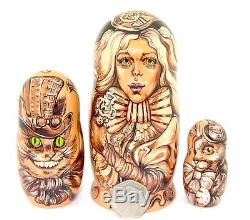
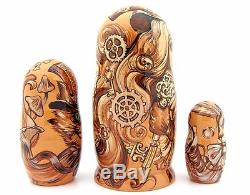
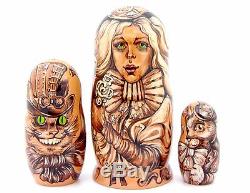
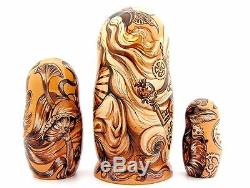
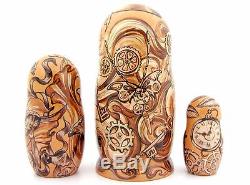
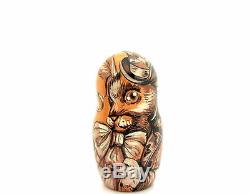

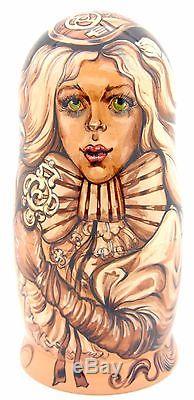
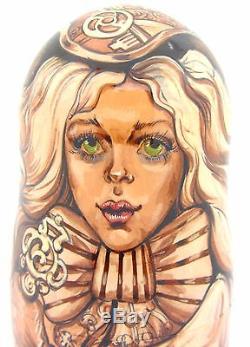


This is a beautiful and unique set of 3. Nesting dolls painted and signed by The Russian Artist Maria ROZE. Hight of the biggest doll is 13.7 cm or 5 3/8 inches.
All my dolls fit inside one another!! Steampunk is a subgenre of science fiction or science fantasy that incorporates technology and aesthetic designs inspired by 19th-century industrial steam-powered machinery. The Mad Hatter (or, according the original novels, simply The Hatter) is a. Alice's Adventures in Wonderland.
And the story's sequel. He has been portrayed on. The Hatter explains to Alice that he and the March Hare. Are always having tea because, when he tried to sing for the Queen of Hearts.At her celebration, she sentenced him to death. For "murdering the time, " but he escapes decapitation. In retaliation, Time (referred to as a "Him") halts himself in respect to the Hatter, keeping him and the March Hare. Stuck at 6:00 forever.
The tea party, when Alice arrives, is characterized by switching places on the table at any given time, making short, personal remarks, asking unanswerable riddles and reciting nonsensical poetry, all of which eventually drive Alice away. He appears again as a witness at the Knave of Hearts. Appears to recognize him as the singer she sentenced to death, and the King. Also cautions him not to be nervous or I'll have you executed on the spot.
When the character makes his appearance as "Hatta" in Through the Looking-Glass. He is in trouble with the law once again. This time, however, he is not necessarily guilty: the White Queen. Explains that quite often subjects are punished before they commit a crime, rather than after, and sometimes they do not even commit it at all. He is also mentioned as being one of the White King.S messengers, and the March Hare appears as well as "Haigha", since the King explains that he needs two messengers: one to come, and one to go. S illustration also depicts him as sipping from a teacup as he did in the original novel, adding weight to Carroll's hint that the two characters are very much the same. Alice's Adventures in Wonderland (1865) is a novel written by English. Author Charles Lutwidge Dodgson under the pseudonym Lewis Carroll.
It tells the story of a girl named Alice who falls down a rabbit-hole. Into a fantasy world populated by peculiar and anthropomorphic. The tale is filled with allusions to Dodgson's friends (and enemies), and to the lessons that British schoolchildren were expected to memorize.The tale plays with logic. In ways that have given the story lasting popularity to adults as well as children.
It is considered to be one of the most characteristic examples of the genre of literary nonsense. Course and structure has been enormously influential, mainly in the fantasy genre. The book is commonly referred to by the abbreviated title Alice in Wonderland , an alternative title popularized by the numerous stage, film and television adaptations of the story produced over the years. Some printings of this title contain both Alice's Adventures in Wonderland and its sequel Through the Looking-Glass, and What Alice Found There.
Alice was written in 1865, exactly three years after the Reverend Charles Lutwidge Dodgson and the Reverend Robinson Duckworth. Rowed in a boat up the River Thames. Lorina Charlotte Liddell (aged 13) ("Prima" in the book's prefatory verse).
(aged 10) ("Secunda" in the prefatory verse). Edith Mary Liddell (aged 8) ("Tertia" in the prefatory verse). The three girls were the daughters of Henry George Liddell. The Vice-Chancellor of Oxford University and Dean of Christ Church as well as headmaster of Westminster School. Most of the book's adventures were based on and influenced by people, situations and buildings in Oxford, England and at Christ Church, e. The "Rabbit Hole" which symbolized the actual stairs in the back of the main hall in Christ Church. The journey had started at Folly Bridge. And ended five miles away in the village of Godstow.To while away time the Reverend Dodgson told the girls a story that, not so coincidentally, featured a bored little girl named Alice who goes looking for an adventure. The girls loved it, and Alice Liddell asked Dodgson to write it down for her. After a lengthy delay over two years he eventually did so and on 26 November 1864 gave Alice the handwritten manuscript of Alice's Adventures Under Ground , with illustrations by Dodgson himself. Speculate there was an earlier version that was destroyed later by Dodgson himself when he printed a more elaborate copy by hand (Gardner, 1965), but there is no known prima facie evidence to support this. But before Alice received her copy, Dodgson was already preparing it for publication and expanding the 18,000-word original to 35,000 words, most notably adding the episodes about the Cheshire Cat and the Mad Tea-Party.
In 1865, Dodgson's tale was published as Alice's Adventures in Wonderland by Lewis Carroll. With illustrations by John Tenniel. The first print run of 2,000 was held back because Tenniel had objections over the print quality. A new edition, released in December of the same year, but carrying an 1866 date, was quickly printed. The binding for the Appleton Alice was virtually identical with the 1866 Macmillan Alice, except for the publisher's name at the foot of the spine.The title page of the Appleton Alice was an insert cancelling the original Macmillan title page of 1865, and bearing the New York publisher's imprint and the date 1866. Alice was a publishing sensation, beloved by children and adults alike. Among its first avid readers were Queen Victoria. And the young Oscar Wilde.
The book has never been out of print. Alice's Adventures in Wonderland has been translated into 125 languages, including Esperanto. There have now been over a hundred editions of the book, as well as countless adaptations in other media, especially theatre and film. Or better yet Be sure to add me to your. And see more unique and interesting things pop up.We speak French , English , German and Russian. Please leave feedback once you have received the item so that i know it has arrived safely. I will leave feedback in return. Smoke & Pet Free Item.
The item "Nesting Russian Dolls Matryoshka Steampunk ALICE Wonderland 3 MAD HATTER RABBIT" is in sale since Sunday, July 1, 2018. This item is in the category "Dolls & Bears\Dolls, Clothing & Accessories\Russian Dolls". The seller is "tom3burma" and is located in Norwich. This item can be shipped worldwide.
- Country/Region of Manufacture: Russian Federation
- Number of Pieces: 3
- Doll Size: 5 in.
- Features: Artist Made
- Brand: Handmade

